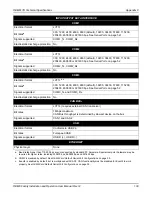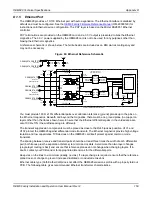
OEM628 Technical Specifications
Appendix D
OEM6 Family Installation and Operation User Manual Rev 12
150
ENVIRONMENTAL
Operating Temperature
-40
C to +85
C
Storage Temperature
-40
C to +85
C
Humidity
MIL-STD-810G, Method 507.5, Procedure II (95%)
Random Vibration
MIL-STD 810G, Method 514.6, Category 24 (7.7 g RMS)
Random Vibration
(OEM628V only)
MIL-STD 810G, Method 514.6, Category 24 (20 g RMS)
Sinusoidal Vibration
IEC 60068-2-6
Bump
ISO 9022-31-06 (25 g)
Shock
Operating: MIL-STD-810G, Method 516.6, Procedure I (40 g)
Non-operating: MIL-STD-810G, Method 516.6 Procedure V (1000 g)
Acceleration
MIL-STD-810G, Method 513.6, Procedure II (4 g, 8 g, 12 g, 16 g)
POWER REQUIREMENTS
Voltage
+3.3 VDC ±5%
Allowable Input Voltage Ripple 100 mV p-p maximum
Power Consumption
1.3 W typical, GPS L1/L2
1.5 W typical, GPS L1/L2, GLONASS L1/L2
1.81 W typical, GPS L1/L2/L5, GLONASS L1/L2, (without L-Band)
1.84 W typical, GPS L1/L2, GLONASS L1/L2 (with L-Band)
1.9 W typical, GPS L1/L2/L5, GLONASS L1/L2, Galileo E1/E5a/E5b/E5, (without
L-Band)
2.13 W typical, GPS L1/L2, GLONASS L1/L2, BDS B1/B2, (without L-Band)
2.3 W typical, GPS L1/L2/L5, GLONASS L1/L2, Galileo E1/E5a/E5b/E5, BDS B1/
B2, (without L-Band)
These power consumption values assume that Ethernet is disabled.
Ethernet draws approximately 220 mw. If you require a reduced power
consumption, turn off the Ethernet port as outlined in
on page 86 and commands described in the OEM6 Family Firmware
Reference Manual.
The above values can change with the number of satellites in view and the
firmware version. Use them as a guide for what you might expect but not as
absolute values
In-Rush Power Consumption
6.6 A for less than 60
s (typical)
















































